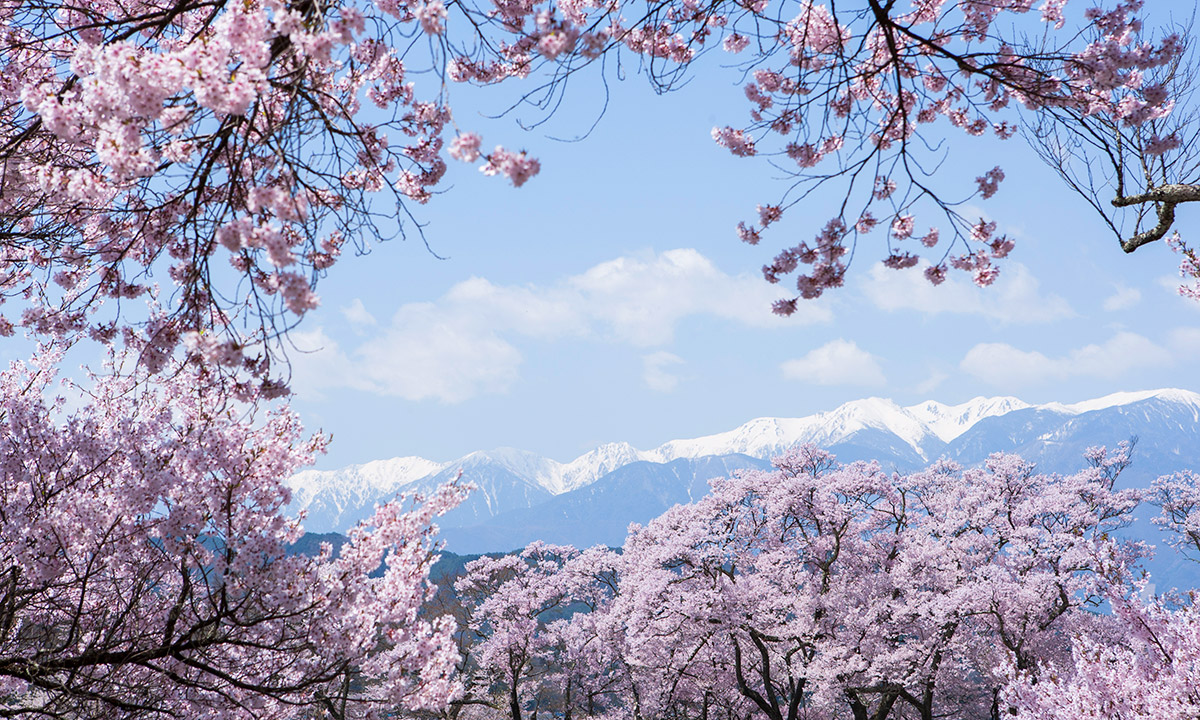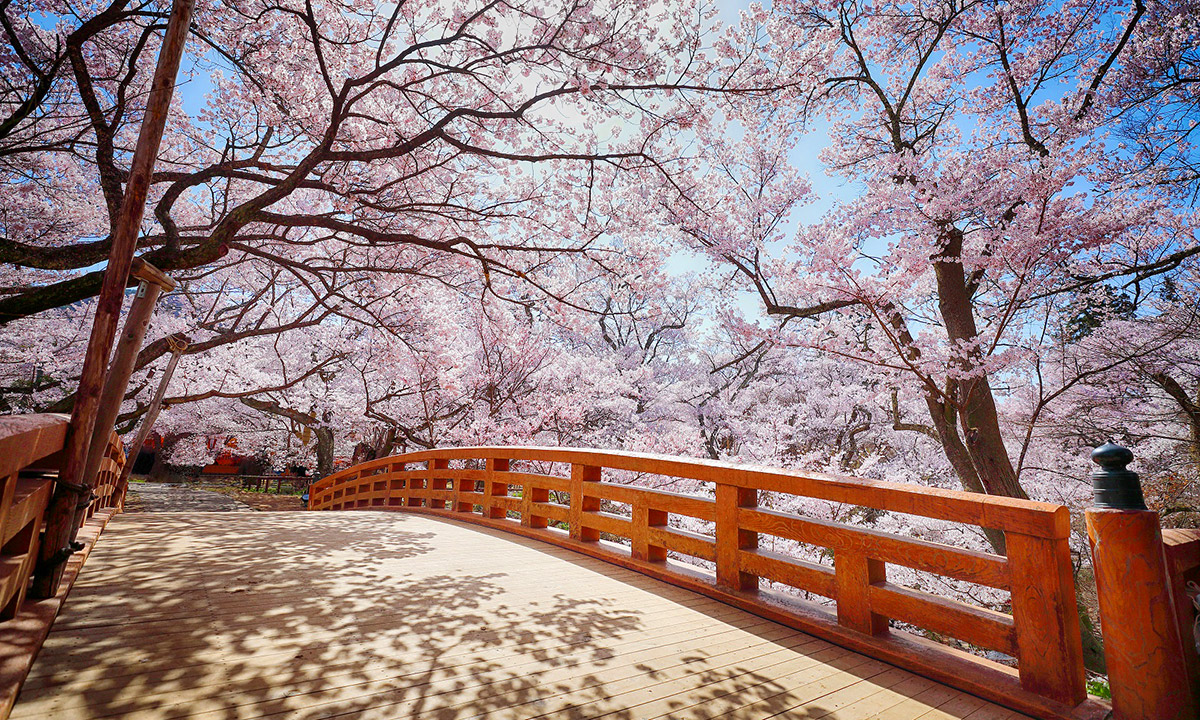|
Centrip Editorial Board
Takato Castle Ruins: Celebrate the arrival of spring with the "Best Cherry Blossoms" in the World

Cherry blossoms are the signal for spring in Japan. Japanese people have a deep affection for cherry blossoms, and it is expressed in Japanese songs.
Japanese pop music has many songs with cherry blossoms as their theme. During the Middle Ages, a poem was written, "If there were no cherry blossoms in the world, we would be able to enjoy spring in peace." This poem expresses the mind of Japanese people who are eagerly looking forward to the blooming of cherry blossoms. It is an interesting work that shows that the love for cherry blossoms has not changed in the past 1200 years.
Did you know that there are three major cherry blossom viewing spots in Japan where you can experience their beauty?
The major cherry blossom areas are Mt. Yoshino (Nara Prefecture), Hirosaki Park (Aomori Prefecture), and Takato Joshi Park (Nagano Prefecture).
Join us as we venture to Takato Joshi Park.
The park is known for its cherry blossoms, which are indigenous to the town of Takato in Ina City, Nagano, and about 1,500 cherry trees are planted here. The amazing views that can only be seen in Takato Joshi Park have a beauty that touches the hearts of all who see it. For this reason, the park is known for "the best cherry blossoms in the world" and is loved by many people.
When it comes to cherry blossoms, the first places foreign visitors think of are Tokyo, Osaka, and Kyoto. The cherry trees there are usually in full bloom during mid-March. Since Nagano is located at a high altitude, the cherry trees usually bloom from early to late April. It always depends on the weather of the year, but the cherry blossoms in Takato Joshi Park in Nagano are best viewed from early to mid-April. Check out the website for the latest information on cherry blossoms in Takato Joshi Park.
Table of Contents
What is Takato Joshi?
History
Joshi means "castle ruins" in Japanese. It is estimated that the castle was built around the 14th century, but the exact date of its construction is unknown.
During the Warring States Period (in the 16th century), the castle was the domain of Takeda Shingen, a warlord who ruled over modern-day Yamanashi Prefecture. The castle has a violent history as it was attacked by the Oda clan in 1582.
Later, during the peaceful Edo period (1603-1868), the castle was guarded by three warrior families (Hoshina, Torii, and Naitou) who passed the castle down from generation to generation.
As the Edo period came to an end, Japan began to modernize. As a result, Takato Castle was closed in 1872, and nearly the entire castle was sold to the private sector. Most of it was dismantled from the buildings, such as the palace and gates, to even the garden stones and trees, leaving very little behind today.
Directions
Takato Joshi Park is located in Ina City, Nagano Prefecture.
It takes about four hours to get there from Nagoya Station by train and bus.
From Nagoya Station, take the JR Chuo Line and ride the Limited Express Shinano No. 7 bound for Nagano to Shiojiri Station.
At Shiojiri Station, take the JR Chuo Line and ride the local train for Tatsuno to Tatsuno Station.
At Tatsuno Station, take the JR Iida Line and ride the local train bound for Tenryukyou to Ina-kita Station.
At Ina-shi Station, take the Nougyo-Koukou - Ina - Takato - Takato-Koukou bus bound for Takato Station, and get off at the Takato Station bus stop.
Take a bus bound for Takato Station, get off at the Takato Station stop, and walk 17 minutes from Takato Station.
Why did Takato Castle Ruins become a famous cherry blossom viewing spot?
 Credit: 伊那市観光協会
Credit: 伊那市観光協会
In 1875, three years after Takato Castle was dismantled, it was decided to make the area into a park in accordance with the governmental policy of modernization. This decision lead to Takato Castle Ruins becoming a famous cherry blossom viewing spot.
In 1876, a group of local samurai dug up cherry trees from "Sakura-no-baba" and planted them in the park. Sakura-no-baba" was a stable located under Takato Castle. It was where samurai used to train their horses in the Edo period. The large cherry trees that lined the sides of the stable were planted in the park.
The cherry trees planted here became the forebearers of the current cherry trees in Takato Castle Ruins Park. Today, there are about 1,500 cherry trees planted around the castle ruins. Twenty trees are more than 140 years old, and around 500 trees are estimated to be over 50 years old.
Another reason why the cherry trees in Takato Joshi Park are so special is because of their variety. In 1960, Takato Joshi Park was designated as a natural monument by Nagano Prefecture as the Kohigan Cherry Blossom Forest of Takato.
The Takato-kohiigan cherry blossom is characterized by its small, reddish flowers. The tree's trunk is impressive as it twists and turns like a dragon.
How to enjoy the cherry blossoms at Takato Castle Ruins
There are two ways to enjoy the cherry blossoms in Takato Joshi Park. The first is to take a closer look at the cherry blossoms in Takato Joshi Park. The other way is to stroll around the park and enjoy the cherry blossoms.
Be sure to check out the information on cherry blossom forecast and recommended days and times when the number of visitors is relatively low!
Highlights of Takato Joshi Park
Ounkyo Bridge
 Credit: 伊那市観光協会
Credit: 伊那市観光協会
Ounkyo Bridge is a symbol of Takato Joshi Park in the cherry blossom season. Its name comes from the cloud-like appearance the cherry blossoms create when in full bloom. When you cross the bridge, the cherry blossoms are within reach and the immersive feeling of being buried in the world of cherry blossoms is almost dream-like.
Also, if you take a picture from directly underneath the bridge, the cherry blossoms create a heart-shaped frame for the sky, a trending hotspot on the social networks. Don't miss this when you visit.
Takato-kaku
 Credit: 伊那市観光協会
Credit: 伊那市観光協会
Takato-kaku, built-in 1936 with donations from local volunteers, is a two-story wooden structure with a traditional East Asian hip-and-gable roof. The building was designed by Ito Bunshiro, a native of Nagano Prefecture who also designed the Imperial Hotel and the NYK head office, and was registered as a Tangible Cultural Property in 2002.
The red-roofed building is a landmark of the castle ruins. In spring, the contrast of the red-roofed building and the cherry blossom trees makes for a beautiful photo spot.
Houdouin-Guruwa
Houdouin-Duruwa is located near the south gate of Takato Joshi Park. During the Warring States period (around the 16th century), there used to be a temple here called Houdouin.
Guruwa is an earthwork enclosure such as stone walls and moats. Today, the remains of the Guruwa look like a hill. Sit on the Guruwa and take in the sight of the beautiful cherry blossoms. Surrounded by the petals of cherry blossoms, will impart a feeling of calm and gentle peace.
 Credit: 伊那市観光協会
Credit: 伊那市観光協会
Cherry blossoms around Takato Joshi Park
Katsuma-Yakushidou: The 140-year-old weeping cherry trees with an air of nobility
Katsuma-Yakushidou is located about a 10-minute walk from Takato Joshi Park. It is famous for its two large weeping cherry trees that are about 140 years old. The weeping cherry trees have drooping branches, and the flowers sway elegantly. They bloom about a week after the cherry blossoms in Takato Joshi Park are in full bloom, so time your trip carefully.
You can also see Lake Takato and the Southern Alps from Katsuma Yakushido.
Recommendations
According to data from the past 10 years, the cherry blossoms in Takato Joshi Park starts to bloom around April 6. However, cherry blossoms do not always bloom as predicted. It depends on the weather and temperature. Check the website such as the Shinshu Ina Takato Cherry Blossom Festival for the latest cherry forecast.
During the cherry blossom season, the park is always very crowded. The best time to visit is on weekdays when there are relatively few people. Also, there are fewer people in the morning and evening. If you are staying near Takato Joshi Park, you can take time to enjoy the cherry blossoms in the morning or at night.
Wrap-up
Cherry blossoms bloom and fall in an instant. Ephemeral describes them in a nutshell. Many Japanese believe cherry blossoms are similar to the flow of life and time.
Japan aimed at becoming a modern nation, like those in Europe, at the end of the 19th century. The long-standing Samurai society came to an end, their castles and swords abolished in an instant.
After the former samurai disappeared in the turbulent times their cherry trees were planted on the site of their castle, which their ancestors had guarded with their lives for generations. I wonder how they would have felt when they planted the cherry trees there?
Cherry blossoms are more profound when you know their history. The history of the cherry blossoms at Takato Castle Ruins are complex, but they are well worth a visit. Why not come and see?
Click here to get the latest information on Central Japan.Centrip Japan - Nagoya and Chubu Information

